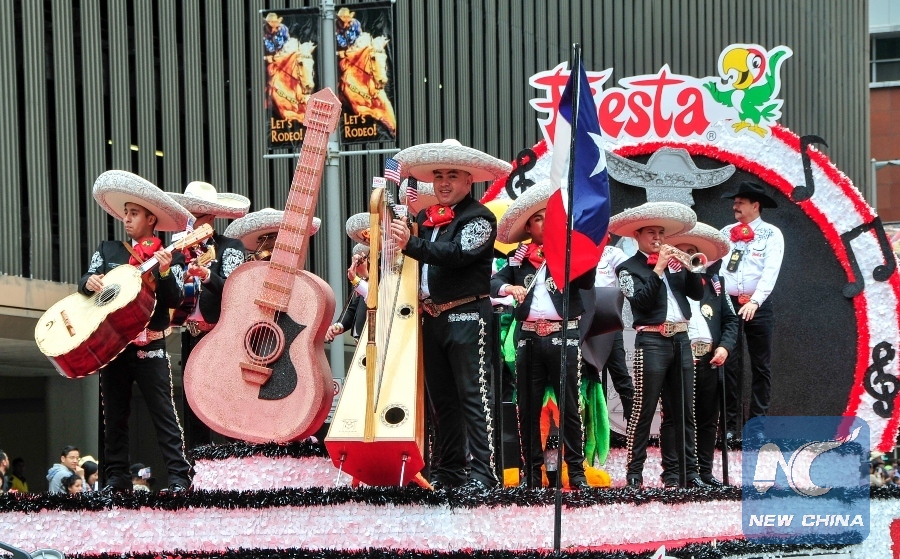
A Mexican band perform during the Houston Rodeo Parade in Houston, the United States, March 4, 2017. (Xinhua/Zhang Yongxing)
HOUSTON, March 27 (Xinhua) -- Texas's professional rodeo cowboys and cowgirls, as well as the state's students in agriculture clubs, walked away with the big payouts from the Houston Livestock Show and Rodeo, the world's largest such event, which ended its 20-day run on March 26.
On Sunday, the winning team among eight professional rodeo competitor groups across the United States was from Texas's Fort Worth Stock Show and Rodeo.
The win of the Rodeo Houston Super Shootout, one of the highest-paid one-day events for rodeo champions only with a total purse of 250,000 U.S. dollars, netted a 12,500 U.S. dollars win for the team and 25,000 U.S. dollars for each of the five team members who demonstrated individual skills in steer wrestling, barrel racing and bareback horse, saddle bronc and bull riding.
The day before, 15-year-old Jagger Horn's Abilene, Texas, FFA project received the highest bid, 345,000 U.S. dollars, to be named the Junior Market Grand Champion Steer.
On the same day, two other FFA Texas students, took first and second places within their categories. Barrel racer Kassie Mowry of Dublin, Texas, took home 60,000 U.S. dollars and tie-down roper Caleb Smidt of Belleville, Texas, earned 58,500 U.S. dollars in the Rodeo Houston Super Series Championship.
Also on Sunday, judges examined 580 student tractor, trailer and farm equipment projects in the Agriculture Mechanics Show at the NRG Center before giving the Grand Champion Agriculture Mechanics Projects title to 4H-Club and FFA students from Tilden, Texas. It was the Tilden FFA's third consecutive win at the Houston Rodeo.
The purse money for champions and the rodeo itself, with its variety of livestock and agriculture educational programs and competitions, star musical entertainers, carnival, vendors and 33,000 volunteers spread out over 350 acres. is a far cry from the Houston rodeo's humble beginnings.
Even its primary mission -- to provide scholarships and other educational support to Texas youth -- has changed since the first event more than eight decades ago.
In fact, it didn't start as a rodeo at all, but a livestock show.
"The Houston Livestock Show and Rodeo originated in 1932 with the purpose of promoting the beef cattle industry in the gulf coast area of Texas," said Allyson Tjoelker, Agricultural Exhibits and Competition executive director. "The first livestock show introduced the Brahman breed which would soon become a prominent cattle breed in the south coast region because of its adaptability."
Free barbecue was provided at the first Houston Fat Stock Show and Livestock Exhibition's downtown event to gather an audience, the forerunner of today's World Championship Bar-B-Que Contest begun in 1974 that features more than 250 teams.
The first rodeo parade in downtown Houston to generate excitement about the livestock show and entertainment provided by cowboys from Texas farms and ranches started in 1937.
The original musical star entertainer, "the Singing Cowboy" and actor Gene Autry, performed at the 1942 show.
Other past highlights include the first educational scholarship, 2,000 U.S. dollars awarded to an agriculture student in 1957 and the name change to Houston Livestock Show and Rodeo in 1961.
The event moved from the now-defunct Sam Houston Coliseum to the newly built Astrodome, for the rodeo, and Astrohall, for the livestock show, in 1966.
Three entertainment attendance records were set on the same day by superstar Elvis Presley, whose first show drew a new record crowd only to be broken by his second show's bigger audience, creating a one-day record total in 1974.
The Reata Committee, which eventually became Go Tejano Day to celebrate Texas-Mexico heritage, began in 1988, and Black Heritage Day started in 1994. Five years later, the number of 4-H and FFA scholarships awarded to students based on financial need and academic achievement totaled 140 four-year awards of 10,000 U.S. dollars.
The entire rodeo moved in 2003 to Reliant Stadium and Reliant Center, its present location now included in NRG Park.
An all-time paid rodeo attendance record set by Mexican musical stars on Go Tejano Day 2009 was broken in 2013, when country singers George Strait, Martina McBride and the Randy Rogers Band drew 80,020 ticket buyers.
Through the decades, most every type of livestock -- including llamas -- has been added to the livestock show, and commercial sales of livestock products attracts buyers from all over the world.
Also added are events including horticulture, school Western art and wine auctions and AgVenture and a children's farm to offer a hands-on agricultural and horticultural education.
"Over the years, we have evolved immensely to provide a diverse offering of open and junior competitions that appeals to both rural and urban participants," Tjoelker said. "With over 27,000 livestock show entries and 50 different competitions, the Houston Livestock Show and Rodeo is the world's largest and most prestigious livestock show."

